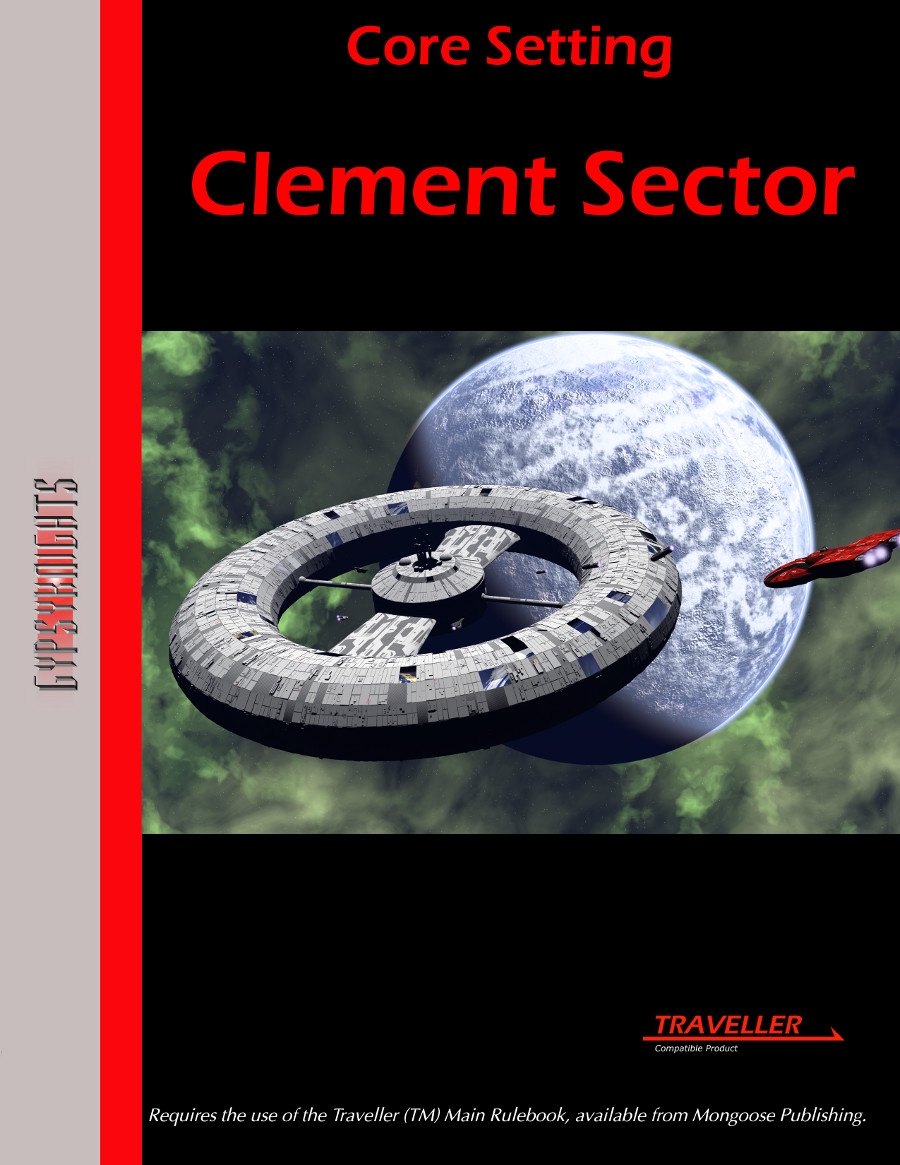Product Review - Clement Sector by John Watts, published by Gypsy Knight Games
 |
| Image borrowed from www.freelancetraveller.com. Image property of Gypsy Knight Games. |
Quick Look at what you get:
140 pages, with scattered illustrations. The first part of the book is the subsector maps and descriptions. From there you get Characters, Starships, Equipment, Travel, Governments, Corporations, Organizations, and Religions.
The Clement Sector book is written to work with the Mongoose Traveller rules, but is described in a general enough way that whichever version of Traveller you play, you can use Clement Sector. The artwork is very good, and nicely divides the chapters, rather than breaking up the text.
History of the Sector:
This book postulates an original future, where mankind reaches out to the stars by the 22nd century, first by Jump-1 drives, here called Zinn drives after its inventor, then by means of a wormhole (The Conduit) which permitted transit to the far side of the Milky Way galaxy. Colonization of solar systems on the far side of the Conduit began, and continued until the early 24th century when the Conduit disappeared, trapping all of the colonists on the far side, with no way to return to near-Earth space.
Subsector Breakdown:
There is only one multi-planet polity in the Clement Sector, the Hub Federation. All other worlds in the sector are independent. The subsector maps are in the normal CT style, and each subsector gets a planet list and a few short notes about inhabited worlds. The bulk of Clement Sector is not inhabited, leaving plenty of room for travel and exploration.
Some notes on some of the chapters:
Characters: Character creation for the Clement Sector follows the standard Traveller rules, except that SOC has been changed to represent wealth & influence, since there are no interstellar entities with aristocratic hierarchies. Skill levels are capped at 4 (perhaps this is a MgT rule) and the skills limit of INT+EDU is specified. Two career tracks are detailed: the Hub Federation Navy and the Cascadia Colonization Authority.
Technology: The most important technology to note is the Zimm drive, which is capable of a maximum of Jump-2. This fact more than any other shapes the colonization of Clement Sector. Tech levels on inhabited planets is very uniform, mostly TL-A and B with exactly two planets at TL-C. This makes sense as the planets have all been colonized within a narrow period of time, but it limits the variety found in a typical Traveller subsector. The specifics of the Zimm drive require that ship size in Clement Sector be limited to 5000 tons.
Starships: The book includes five starships, complete with deckplans and MgT style ship stats, which again are easy to convert to other editions of Traveller. The deck plans and artwork again are very good.
Corporations/Organizations: A goodly selection of business and civil groups, described in about a half a page. The Stellar Purity group sounds likely as a recurring villain group with their nutty philosophy.
Politics: A brief overview of the state of relations between planets. You would not think that there would be much political action with each planet being a separate government, it should be very hard to prosecute a war on that scale.
Religion: This section acknowledges the continued existence of Earth's dominant religions, then invents two more. One is a vague Force-like religion with an ill-defined evil entity, and the other is Mormonism in a funny hat.
Aliens: Clement Sector has no aliens – but it looks like they used to. Several sites are described where objects of clearly not-human manufacture have been discovered. What does this mean for the Sector? Only the referee can say.
Wrap-up: This book has what any Traveller resource should have – a framework which the referee can build upon to create unique and original adventures. Lots of material to work with here! The index at the rear of the book is a welcome tool, not all rpg books, by any means, are indexed.
The Best part is:The Clement sector is wide open, and still has lots of actual frontier. The higher tech levels are still to be developed, and there is no Imperium enforcing stability. Ambitious PCs can really shape the course of the Sector, if they're lucky.
This could have been better: I would have liked more variety with the Tech Levels. I respect the decision to cap everything at TL-B/C, but there should be some more planets further down the chart at 5, 6 or 7.
Putting my own spin on it: I would have pre-set a few more multi-planet states, spaced far enough apart to have spheres of influence that sometimes overlap. I also would have focused more on the place of the Church in Clement sector, and left out the faux-Mormons.
I am stealing this idea: There are five starship types described, with stats and deckplans. They will be making an appearance in my TU, especially the Atlas-class freighter. Also, the format for describing the Corporations and Organizations - one page, logo at the top and 400-500 words to give just enough structure that the referee can take it and run. I plan to create and share a few more corporations in my TU, using this format.
No comments:
Post a Comment